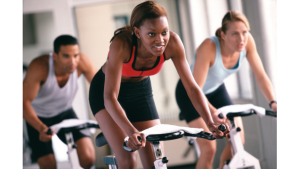YOUR 20s
In your 20s your pituitary gland is firing on all cylinders, namely with human growth hormone, meaning it’s easier to tone up than at any other point in your life. Cash in on this by lifting as heavy weights as you can – this’ll bank muscle memory for your 30s and 40s.
“Choose a load you can do no more than six reps with, then do five sets,” says sports scientist and personal trainer Luke Worthington, who advises focusing on the frequency of your workouts rather than the loads you lift. “In your 20s, you’re set up perfectly for recovery, so four strength training sessions plus two cardio ones per week is totally achievable.” You heard the man.
Diet – Now is not the time to ditch the dairy. Peak bone mass is reached between the ages of 25 to 30 so you should capitalise on your calcium. If you don’t want to get your 1000mg RDI all from milk (one glass of the white stuff brings around 300mg calcium to the table) this diet will get you your RDI: cereal with one glass of milk for breakfast, a salad with two cups of spinach at lunch, followed by salmon with three cups of cooked greens (think broccoli and kale). Easy.
Health tests – Cholesterol might seem like a granny’s issue, but getting a lipids profile done at 25 (then every five years after that) will help you guard against heart problems in later life. Ask your GP for a full screen, not just your total cholesterol number.
Body alignment analysis – Your external skeleton reaches full maturity by your mid-20s, so now is the time to check your body’s alignment. “You might not be aware if you’re knock-kneed or have a misaligned hip,” says biomechanical expert Serena Stubbs. “But by your 30s and 40s, if not looked at, they can cause problems further down the line.” Ask your physio or osteo.
YOUR 30s
Your human growth hormones take a bit of a nosedive in this decade. Translation: it’s harder for you to build and maintain muscle mass. “Scheduling in de-load weeks every four to six weeks (reducing the weight you lift during your workouts, but without stopping training) is crucial,” says Worthington.
“[As is] having recovery goals in addition to your training goals – such as drinking four litres of water a day or getting seven hours’ sleep per night. Your body just isn’t bulletproof like it was in your 20s.” He also advises focusing on dynamic warm-ups and soft-tissue work with a foam roller from now.
Diet – Two words: arthritis and osteoporosis. Your 30s is the time when the most damage is done to your bones. Lean on omega-3s to help prevent the conditions. Aim for two to three serves of oily fish a week. Salmon and tuna aren’t the only options – blue-eye trevalla, gemfish, silver perch and rainbow trout contain mega omegas. Fish too fishy for you? You know the drill – take a supplement.
Health tests – Cervical cancer occurs mainly in women over 35, so a few moments of discomfort during a smear test are totally worth it.
Thyroid test – The minute that 35th birthday candle is blown out, it’s time to test your thyroid function. A blood test for thyroid stimulating hormone (TSH) screens for an underactive or overactive thyroid, conditions that can cause weight gain and loss, mood swings, anxiety and bad skin.
Vitamin D test – As you age, your risk of vitamin D deficiency increases – and that condition’s linked to heart disease, asthma and cancer as well as poor bone health. Ask your GP to take a look.
YOUR 40s
Each year after 35, you gain four per cent wisdom but lose one per cent muscle mass. True story – the second part, at least. But good old strength training helps you hold on to the lean tissue you have. “Lower reps with higher loads helps guard against osteoporosis,” says Worthington. “Try weights twice a week, a brisk walk twice a week and soft tissue work (foam-rolling, yoga, pilates) every day.”
Diet – The energy you burn doing bugger all decreases by seven per cent every decade after 30, so try to avoid refined carbs and load up on low-GI foods rich in soluble fibre, which helps lower bad cholesterol. Switching from toast to porridge at breakfast could cut cholesterol by 10 per cent. Women under 50 need 25g fibre a day to help with everything from digestion to heart health – 28g flaxseeds have 8g fibre, so add to smoothies, salads and stews.
Hormones – It might be a little early to mention the M word (menopause, not mudcake), but your ovaries’ last hurrah – the perimenopause – starts five to 10 years before. As the average age of menopause is 52, that means you experience symptoms soon after the big 4-0.
“Some women stop producing the progesterone needed to mop up excess oestrogen,” says hormone expert Dr Jan Toledano. This can cause mood swings and poor sleep. Vitamin C can boost levels. And cut out caffeine and alcohol before your period to reduce symptoms.
Health tests – Ask your GP to check your blood pressure, cholesterol and BMI against your stroke and heart disease risk.
Eye exam – Medicare covers the cost of an eye test every two years. Book an appointment with an optometrist who can check for glaucoma, cataracts and macular degeneration.
Diabetes test – Your type-2 diabetes risk increases with age, especially once you hit 40. After age 45, get a test every three years. If you’re overweight, it’s every other year. Put it in the diary.


